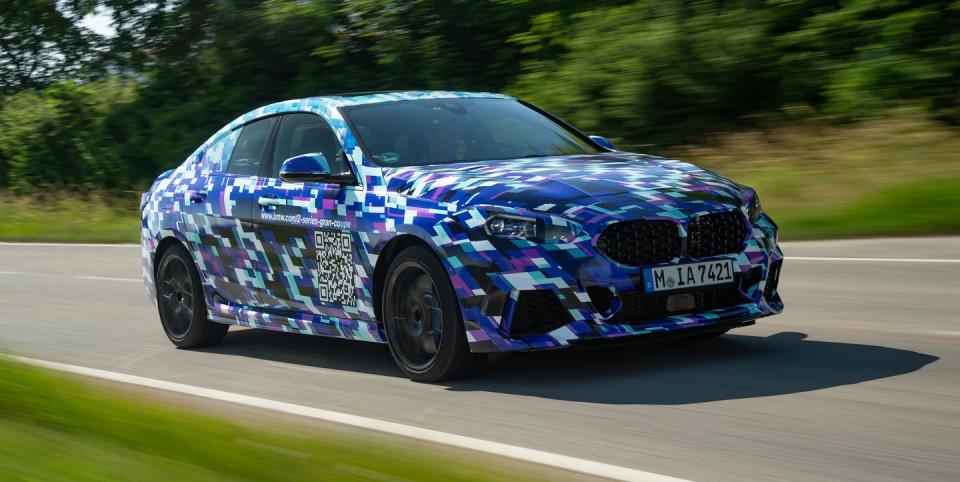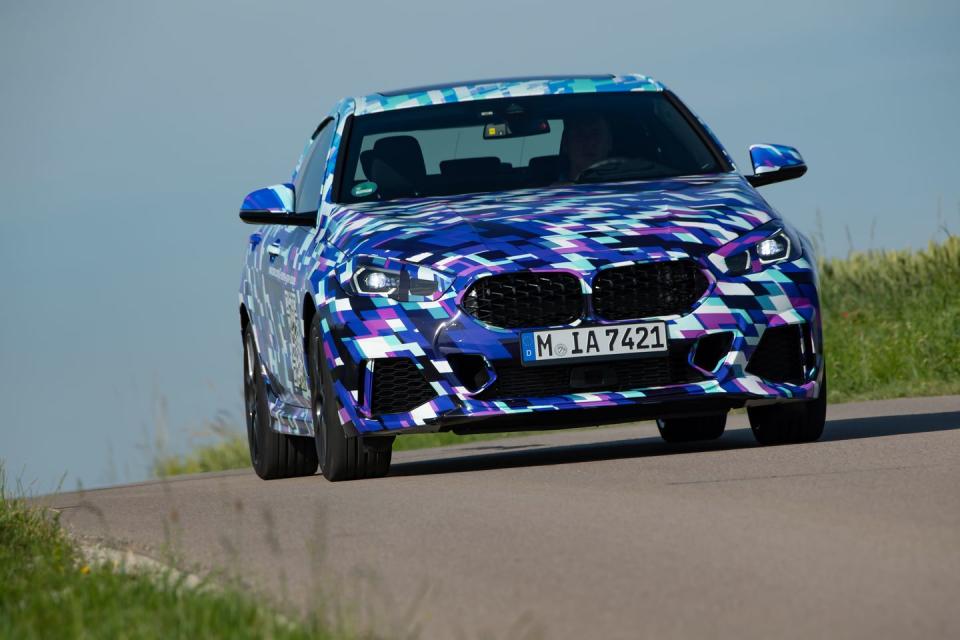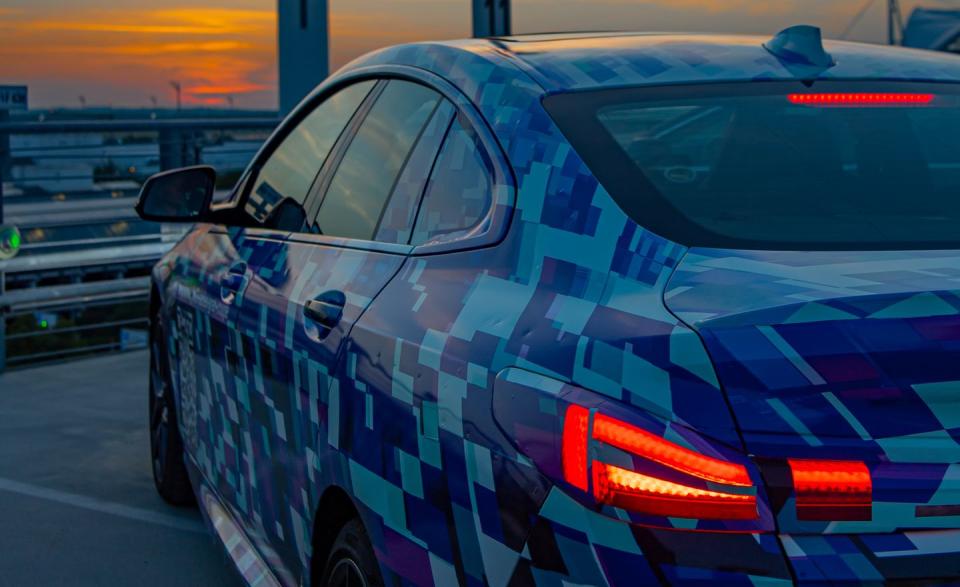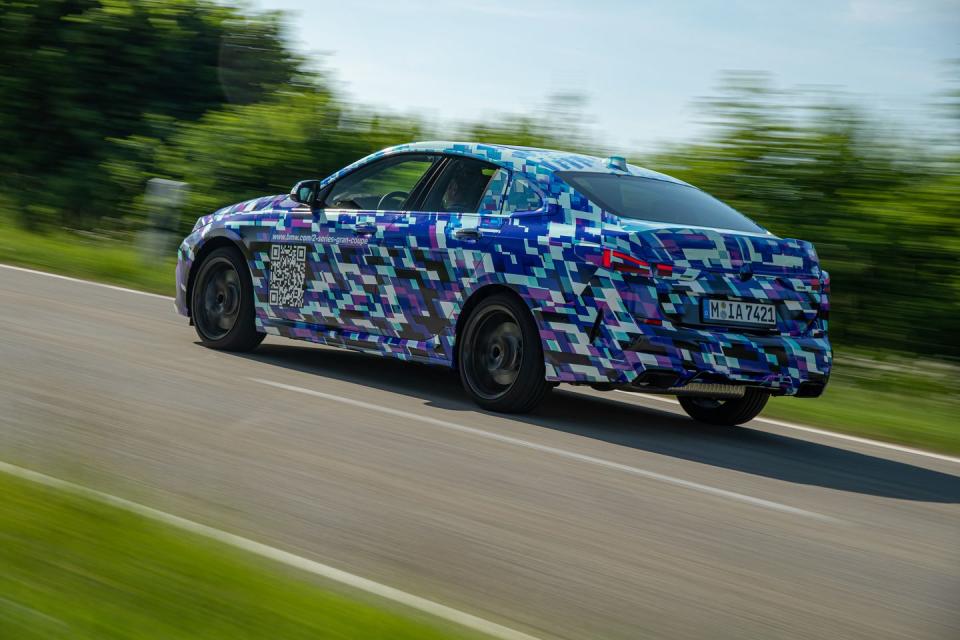Compact 2020 BMW 2-series Gran Coupe Prototype Is Still Very Much a BMW

Within a radically evolving world now flush with Lamborghini SUVs and mid-engine Chevy Corvettes, there's little point in fighting the fact that, with the 2020 2-series Gran Coupe, BMW will be selling its first (gulp) front-wheel-drive–based car in the United States. Tradition, at least in today's automotive universe, is anything but sacred. Curious as to what we can expect when this smaller-than-a-3-series four-door goes on sale early next year, we jumped on BMW's invitation to drive a pair of pre-production development mules in Germany.
Power and Style
Despite its 2-series moniker, the Gran Coupe (GC) is not a sedan version of the current, 2-series coupe and convertible that happens to feature longitudinal engines and rear-wheel drive. Its engine sits transversely rather than longitudinally, and it shares much of its UKL platform with BMW's new 1-series hatchback that's available in other markets (the X1 SUV and the X2 fastback crossover also are part of this vehicle family). BMW will unveil the GC officially at this fall's Los Angeles auto show, but we can confirm that it will be available in both 228i and M235i specifications. An xDrive all-wheel-drive system that can route up to 50 percent of the engine's torque to the rear axle will be standard on both U.S. versions. Similar to the X2, turbocharged 2.0-liter inline-fours will motivate both models, with the 228i producing about 225 horsepower and the higher-test M235i good for at least 300 ponies. An Aisin-sourced eight-speed automatic will be the only transmission.

BMW took its time in entering this market space, and the 2-series GC's dimensions—as well as many of its specs in general—fall near those of its two main competitors, the Audi A3 and the Mercedes-Benz CLA-class, both of which have been on sale for several years. (The CLA has been redesigned for 2020.) The colorful camouflage wraps on our test cars obscure some of their surface sculpting, but the Bimmer's styling also sits somewhere in the middle of its peers'. The faster roofline and greater detailing lend it more presence and character than the Audi, though its profile is not as sleek nor as elegant as the Benz's. Other than their rolling stock—17-inch wheels are standard on the 228i, and 18s are optional; the M235i rolls on standard 18-inchers with 19s available—exterior differences between the two GC models are modest, with the M235i wearing a more aggressive front fascia, as well as its own grille and tailpipe treatments. While a shorter dash-to-axle ratio and a longer front overhang make the 2-series GC's proportions appear a bit stubby compared with rear-drive BMWs, it is relatively attractive overall.
Capable and High-Tech
Except for an aluminum hood, the GC's chassis and body are mostly steel, and curb weights should range from 3400 to 3500 pounds. M235i models come standard with a limited-slip front differential, quicker steering, and adaptive dampers; the steering and dampers will be optional on the 228i. Other notable options will include more supportive front sport seats and upgraded brake hardware, likely as elements of a larger sport package. BMW says that the M235i should be able to reach 60 mph in less than 5.0 seconds, which should be entirely doable, given that we've already recorded a stout 4.6-second time from the mechanically similar and surely heavier X2 M35i xDrive.
We can't comment on how thrusty the M235i actually feels on the road, though, as the development car decided that our test drive was a good time to illuminate a check-engine light that ultimately sapped a good chunk of its power. What we can say is that the soundtrack for the M235i's boosted four is overly synthesized through the audio system's speakers, especially in the car's sportier driving modes. The 228i, in contrast, keeps with a more natural tone and is fully capable of maintaining a triple-digit pace on the German autobahn. In its near-production state of tune, the GC's automatic transmission managed its gear selections well yet without the refined haste that we've come to expect from the ZF eight-speed 'box found in rear-drive BMWs. Throttle response was good, but shift quality was generally on the lazy side except in full-throttle situations, during which the automatic often traded smoothness for speed and slammed its shifts into higher gears.

Our brief stint over the narrow two-lane farm roads outside of Munich offered few opportunities to exploit the Gran Coupe's chassis tune, which seemed to vary minimally between the selectable Comfort and Sport drive settings. Nicely managed body motions contributed to a solid and planted feel; a pleasantly sorted ride soaked up what few bumps we could find without upsetting the strut front and multilink rear suspension; and precise steering directed a nose willing to tackle corners.
Perhaps the GC's most interesting piece of technology is the revised programming for its stability control system, which eventually will spread throughout BMW's lineup and applies knowledge from the brand's development of the i3 electric car. Because an electric motor is far quicker to respond to stability control overrides than an internal-combustion engine, according to BMW, the new system—referred to as near-actuator wheelslip limitation in Bimmer-speak—essentially provides a faster data pathway for the GC's various sensors by allowing the car's stability control processor to act on the engine directly rather than in coordination with the main engine computer. A couple of purposely hot corner entries showed that the system is indeed quick to intervene when it senses danger, but we'll hold off on a closer evaluation until we get a car to the relative safety of the test track.

Radical Yet Familiar
BMW has yet to release photos of the Gran Coupe's interior but pulling back the felt blankets draped over our test cars' panels revealed a familiarly stoic BMW decor, complete with the brand's latest switchgear, infotainment, and steering wheel layouts. Expect material quality and equipment levels to closely hew to those of the 3-series, as well as a decent trunk with about 15 cubic feet of space. Comfortable front seats and an amply adjustable steering column make it easy to get situated. Arguably just as important for a compact sedan is that a pair of six-footers will fit in the back seat, although their coifs will brush the headliner and their knees will be thankful for the significant cutouts in the backs of the front buckets.
Given the $41,745 base price of the starter 2020 BMW 330i sedan, we expect an entry fee for the 2-series Gran Coupe in the upper $30,000s, similar to that of the latest Mercedes CLA250. The M235i model, with sights set squarely on the Mercedes-AMG CLA35, should easily top $50K with options. That most modern BMWs, rear-drive or otherwise, aren't the paragons of joy and steering fidelity they once were makes it somewhat easier to accept the GC's inherently duller front-drive handling dynamics. A "traditional" BMW or not, the four-door 2-series, even in a premature state, feels every bit the modern BMW that it needs to be.
You Might Also Like

 Yahoo Autos
Yahoo Autos 